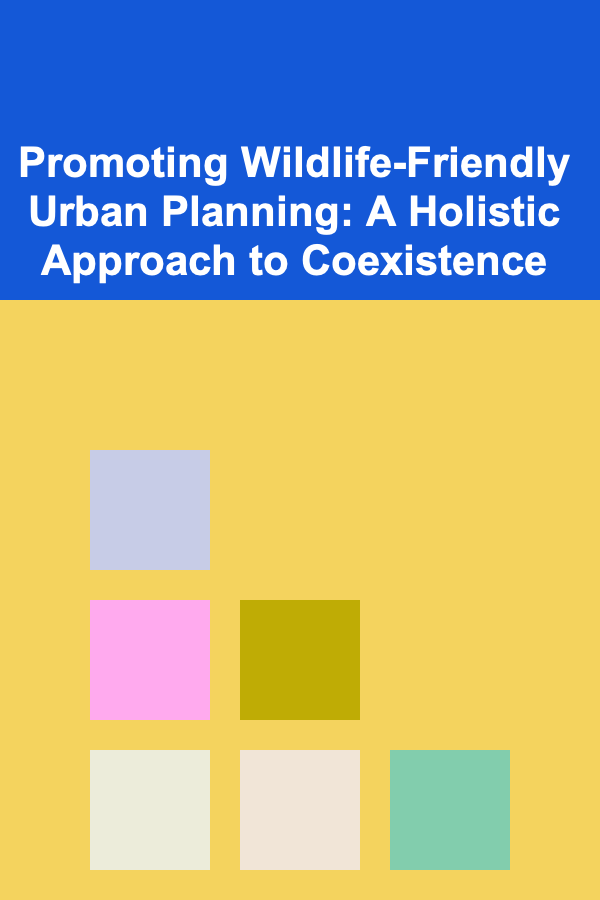
Promoting Wildlife-Friendly Urban Planning: A Holistic Approach to Coexistence
ebook include PDF & Audio bundle (Micro Guide)
$12.99$6.99
Limited Time Offer! Order within the next:

The relentless march of urbanization, a defining feature of the 21st century, presents a profound paradox. While cities are centers of human innovation, culture, and economic activity, they are simultaneously significant drivers of global biodiversity loss. The expansion of concrete jungles, the fragmentation of natural habitats, and the myriad forms of pollution stemming from urban centers exert immense pressure on wildlife populations. Yet, a growing awareness of the ecological crisis and the intrinsic value of biodiversity is catalyzing a paradigm shift: from managing wildlife around cities to actively integrating nature within urban planning. This transformative approach, known as wildlife-friendly urban planning, seeks to foster genuine coexistence between human inhabitants and the diverse species that share our planet, transforming cities into vibrant ecological mosaics. This article will delve into the multifaceted strategies required to promote such planning, encompassing policy, design, community engagement, technological innovation, and long-term stewardship, ultimately envisioning a future where cities are not merely human habitats but thriving ecosystems for all life.
Understanding the Challenge: Urbanization's Impact on Wildlife
Before exploring solutions, it is crucial to comprehend the depth and complexity of urbanization's impact on wildlife. The urban environment is characterized by a unique set of ecological pressures that drastically alter natural systems and species behavior. The most obvious, and arguably most destructive, impact is habitat loss and fragmentation. As cities expand, natural areas -- forests, wetlands, grasslands -- are converted into impermeable surfaces and built structures. This not only destroys existing habitats but also fragments remaining patches, isolating populations and hindering genetic flow. Small, isolated populations are more vulnerable to local extinction due to disease, random environmental events, and lack of genetic diversity.
Beyond direct habitat destruction, urban areas introduce various forms of pollution . Light pollution , with its omnipresent glow, disrupts nocturnal animal behaviors, impacting migration patterns, foraging, reproduction, and predator-prey dynamics for a vast array of species, from migratory birds to insects and bats. Noise pollution from traffic, construction, and human activity can mask communication signals, elevate stress levels, and alter foraging efficiency for many animals. Chemical pollution, including pesticides, herbicides, industrial runoff, and pharmaceutical waste, contaminates soil and water bodies, poisoning wildlife and disrupting ecological processes. Furthermore, altered hydrological regimes due to extensive impervious surfaces lead to increased stormwater runoff, often laden with pollutants, severely degrading urban waterways and aquatic ecosystems.
The proximity of humans and wildlife inevitably leads to human-wildlife conflict. This can range from nuisance issues like urban pests raiding gardens to more serious encounters involving large carnivores or venomous snakes. Conflict often arises from misconceptions, inadequate waste management, or the artificial provision of food sources, leading to negative perceptions of wildlife and, at times, retaliatory actions against animals. The spread of diseases, both from humans to wildlife (e.g., domestic pet diseases) and vice versa (zoonoses), also becomes a heightened concern in dense urban settings.
Urbanization also profoundly alters ecological processes. Natural food webs are disrupted as key species disappear or new, often invasive, species dominate. Predation patterns change, and the availability of natural food and water resources is often replaced by human-provided alternatives, leading to dependence and behavioral shifts. The urban heat island effect, where metropolitan areas are significantly warmer than surrounding rural areas, can exacerbate climate change impacts, alter phenology (seasonal timing of biological events), and stress species already at their physiological limits. Some species, known as "urban adapters" (e.g., raccoons, pigeons, coyotes), thrive in these altered conditions, while others, "urban avoiders," decline rapidly. For some, urban areas can become "ecological traps," superficially attractive but ultimately detrimental environments.
Foundational Principles of Wildlife-Friendly Urban Planning
At the heart of successful wildlife-friendly urban planning lies a set of core principles that guide decision-making and design. These principles move beyond mere mitigation of harm to active integration and enhancement of ecological values within the urban fabric.
Connectivity: The Lifelines of Urban Nature
Ecological connectivity is paramount. It refers to the degree to which landscape features facilitate the movement of organisms and ecological processes. In an urban context, this means creating and maintaining green corridors, stepping stones, and ecological networks that link isolated green spaces, allowing animals to move between habitats, access resources, and maintain genetic diversity. These networks can take many forms: riparian buffers along rivers, greenways along disused rail lines, tree-lined streets, or even a series of interconnected community gardens. The goal is to overcome the fragmentation inherent in urban landscapes.
Diversity: Nurturing Urban Biodiversity
A truly wildlife-friendly city embraces diversity -- not just of species, but of habitats and ecological structures. This means designing urban landscapes that provide a variety of niches, from tree canopies for birds and bats to diverse understories for insects and small mammals, and healthy wetlands for amphibians. Utilizing native plant species is crucial, as they form the foundation of local food webs, providing appropriate food (nectar, seeds, fruits) and shelter for native wildlife. Promoting structural diversity through varying heights of vegetation, rock piles, and log piles creates microhabitats essential for many species.
Minimizing Harm: Reducing Anthropogenic Impacts
While integration is the long-term goal, immediate efforts must focus on reducing the negative impacts of human activity. This includes comprehensive strategies to mitigate light, noise, and chemical pollution. It also involves designing infrastructure that reduces wildlife mortality (e.g., bird-friendly glass, wildlife crossings) and implementing effective waste management to minimize human-wildlife conflict. Education plays a critical role here, informing residents about responsible pet ownership, discouraging feeding of wildlife, and promoting safe coexistence strategies.
Resilience: Building Robust Urban Ecosystems
Cities are increasingly on the front lines of climate change. Wildlife-friendly urban planning must therefore prioritize the creation of resilient ecosystems that can adapt to changing environmental conditions. This involves fostering diverse gene pools, ensuring connectivity for species migration as climates shift, and implementing green infrastructure that mitigates urban heat island effects, manages stormwater, and improves air quality. Resilient ecosystems are better equipped to absorb disturbances and maintain their ecological functions.
Integration: Nature as a Fundamental Element
Perhaps the most crucial principle is that wildlife considerations must be integrated into urban planning from the outset, not as an afterthought or a reactive measure. This means incorporating ecological data and wildlife needs into every stage of planning: master plans, zoning ordinances, infrastructure projects, and building design. It requires interdisciplinary collaboration among urban planners, ecologists, landscape architects, engineers, and community stakeholders to ensure that ecological objectives are woven into the very fabric of urban development.
Context-Specificity: Local Ecology Dictates Design
There is no one-size-fits-all solution for wildlife-friendly urban planning. Each city possesses unique ecological characteristics, indigenous species, and social dynamics. Effective planning must be deeply rooted in an understanding of the local biome, the specific needs of native wildlife, and the cultural context of the human population. This requires thorough ecological surveys, stakeholder engagement, and adaptive management approaches that are responsive to local conditions and evolving knowledge.
Policy and Regulatory Frameworks: The Backbone of Change
While design and community action are vital, meaningful and lasting change in urban planning requires robust policy and regulatory frameworks. These provide the legal and administrative mandates, incentives, and guidelines necessary to embed wildlife considerations into the urban development process.
Comprehensive Planning and Zoning
The foundation of wildlife-friendly urban planning lies in integrating ecological data directly into master plans and zoning ordinances. This means identifying sensitive habitats, wildlife corridors, and significant natural features early in the planning process and designating them for protection or specific low-impact development. Zoning can differentiate between areas where intensive development is permitted and areas designated as ecological protection zones, greenbelts, or conservation easements. Strategic zoning can also promote compact, mixed-use development, thereby reducing urban sprawl and preserving peripheral natural areas.
Environmental Impact Assessments (EIAs)
Strengthening the wildlife criteria within Environmental Impact Assessments (EIAs) is crucial. EIAs should not merely identify potential negative impacts but also mandate and monitor specific mitigation measures for wildlife and their habitats. This includes requiring detailed biodiversity surveys, assessing cumulative impacts across projects, and demanding compensatory habitat creation or restoration where unavoidable impacts occur. Post-development monitoring should also be a standard component to ensure compliance and effectiveness.
City-Level Biodiversity Action Plans (BAPs)
Many cities are now developing their own Biodiversity Action Plans (BAPs), tailored to local ecological conditions and urban development goals. These plans set specific, measurable targets for biodiversity conservation, identify key species and habitats, and outline actionable strategies for their protection and enhancement within the urban matrix. A BAP provides a roadmap for various city departments, guiding investments in green infrastructure, land management practices, and educational initiatives.
Protective Legislation and Ordinances
Local governments can enact specific legislation to protect critical urban habitats and species. Examples include:
- Tree Ordinances: Protecting mature trees, especially native species, and mandating tree planting in new developments.
- Wetland Protection: Strict regulations against filling or disturbing urban wetlands, recognizing their role in biodiversity and ecosystem services (e.g., water purification, flood control).
- Stream and Riparian Buffer Requirements: Mandating vegetated setbacks along waterways to maintain water quality, provide habitat, and create wildlife corridors.
- Dark Sky Ordinances: Regulating outdoor lighting to reduce light pollution, benefiting nocturnal wildlife and human health.
- Bird-Friendly Building Codes: Requiring specific glass treatments or building designs to minimize bird collisions.
Incentives and Disincentives
Governments can leverage financial and regulatory tools to encourage wildlife-friendly practices:
- Tax Incentives/Breaks: For developers or homeowners who incorporate significant green infrastructure, native landscaping, or habitat restoration.
- Density Bonuses: Allowing higher density in compact development areas if developers preserve substantial natural areas or integrate high-quality green infrastructure.
- Expedited Permitting: For projects that demonstrate exceptional commitment to ecological sustainability.
- Development Fees: Imposing fees on projects that result in significant habitat destruction, with funds earmarked for habitat restoration elsewhere.
- Performance-Based Zoning: Shifting from prescriptive zoning to outcomes-based zoning, where developers must demonstrate how their project meets specific ecological performance criteria.
Cross-Jurisdictional Collaboration
Ecological systems do not adhere to administrative boundaries. Effective wildlife-friendly urban planning often requires regional planning and collaboration among adjacent municipalities, county governments, and even state/provincial agencies. This is particularly vital for establishing large-scale ecological corridors, managing shared watersheds, and addressing transboundary wildlife populations. Joint commissions or regional conservation agreements can facilitate this necessary cooperation.
Smart Growth Principles
Promoting smart growth principles inherently supports wildlife conservation. By encouraging compact, walkable, mixed-use development and investing in existing infrastructure, smart growth reduces the pressure for urban sprawl into natural areas. It emphasizes preserving open space, agricultural lands, and critical habitats, channeling development towards already urbanized zones.
Design and Infrastructure: Shaping the Urban Landscape
Policy sets the framework, but design and infrastructure are where wildlife-friendly principles are concretized into the physical urban landscape. This involves a fundamental rethinking of how we build and manage our cities, moving beyond purely utilitarian infrastructure to embrace ecological functionality.
Green Infrastructure Networks
The concept of green infrastructure is central to wildlife-friendly urban planning. It refers to a strategically planned and managed network of natural and semi-natural areas that deliver a wide range of ecosystem services. This network can be designed to provide habitat, facilitate wildlife movement, manage stormwater, improve air quality, and offer recreational opportunities. Key components include:
- Urban Parks and Natural Reserves: Designing parks with diverse native vegetation, varied topography, and minimal human disturbance in designated areas. Integrating natural features like streams, ponds, and forests within parks.
- Community and Allotment Gardens: Beyond food production, these can be designed to support pollinators, provide nesting sites, and contribute to local biodiversity if planted with native species and managed organically.
- Rooftop Gardens (Green Roofs): Providing habitat for birds, insects, and small invertebrates, especially if planted with drought-tolerant native species. They also absorb stormwater, insulate buildings, and mitigate urban heat island effects.
- Vertical Greenery (Living Walls): Though sometimes limited in habitat value compared to green roofs, they can provide climbing surfaces and foraging opportunities for insects and some bird species, while also improving air quality and aesthetics.
- Permeable Surfaces: Reducing impervious areas by using porous pavement, permeable pavers, and gravel paths allows for groundwater infiltration, reduces stormwater runoff, and supports soil biodiversity.
- Bio-swales, Rain Gardens, and Constructed Wetlands: These features are critical for sustainable urban drainage systems (SUDS). They filter pollutants from stormwater, absorb excess water, and provide vital wetland habitats for amphibians, aquatic insects, and birds.
Corridor Design
Effective wildlife movement often requires specific design interventions:
- Wildlife Overpasses and Underpasses: Critically important structures, especially on major highways, that allow large mammals and other wildlife to safely cross roads, preventing collisions and connecting fragmented habitats. These must be appropriately sized, vegetated, and located based on wildlife movement patterns.
- Riparian Buffers and Greenways: Establishing wide, vegetated buffers along rivers, streams, and other water bodies creates natural corridors for aquatic and semi-aquatic species, as well as land animals using water sources. These greenways can often double as recreational trails.
- Hedgerows and Treed Avenues: In more developed areas, continuous lines of trees and shrubs can connect smaller green spaces, offering cover and travel routes for birds, insects, and small mammals.
- Habitat 'Stepping Stones': Even small, isolated patches of high-quality habitat (e.g., a cluster of native trees, a pond, a dense shrub thicket) can serve as stepping stones for migratory birds or insects, allowing them to rest and refuel.
Building Design for Wildlife
Buildings themselves can be designed to minimize harm and offer habitat:
- Bird-Friendly Glass: Applying patterns (e.g., frit, dots, lines), UV coatings, or angling glass to make it visible to birds can drastically reduce fatal collisions.
- Light Pollution Mitigation: Using downward-shielded, full cut-off luminaires to prevent light spill into the sky; employing motion sensors; selecting warmer color temperatures (amber/red spectrum); and timing lights to be off during peak migratory periods.
- Integrated Habitat Elements: Incorporating "bat bricks" (cavities for bats), "swift boxes" (nesting sites for swifts), or dedicated insect hotels into building facades provides vital nesting and roosting opportunities.
- Green Roofs and Walls: As mentioned, these can become elevated habitats, particularly valuable for pollinators and invertebrates, and even some bird species, if appropriately designed with native vegetation and substrate depth.
Transportation Infrastructure
Beyond wildlife crossings, the broader transportation network impacts wildlife:
- Reducing Road Mortality: Implementing speed limits in sensitive areas, warning signs, and fencing along key stretches of roads to funnel wildlife to safe crossing points.
- Promoting Public Transit and Active Transportation: Reducing reliance on private vehicles decreases per capita impervious surface area and vehicle miles traveled, lessening overall habitat fragmentation pressure.
Water Management
Naturalizing urban waterways and adopting sustainable water management practices are critical:
- Daylighting Streams: Uncovering previously culverted or piped streams, restoring their natural flow, and creating riparian habitats.
- Naturalized Shorelines: Replacing concrete banks with native vegetation along rivers and ponds to create diverse habitats for fish, amphibians, and invertebrates.
- Rainwater Harvesting: Reducing the volume of runoff and retaining water on-site, benefiting local groundwater and reducing stress on natural water bodies.
Waste Management
Effective waste management is a simple yet powerful tool for reducing human-wildlife conflict. Secure, wildlife-proof waste receptacles and regular collection reduce attractants for urban adapters like raccoons, coyotes, and rodents, discouraging their dependence on human food sources and minimizing negative interactions.
Community Engagement and Education: Fostering Stewardship
No amount of policy or design will succeed without the active participation and support of the community. Fostering a sense of stewardship, educating residents, and empowering local action are indispensable components of wildlife-friendly urban planning.
Public Awareness Campaigns
Cities must invest in clear, engaging public awareness campaigns that explain the "why" and "how" of wildlife-friendly living. These campaigns can highlight the benefits of urban biodiversity (e.g., cleaner air and water, psychological well-being, pest control by natural predators), identify common urban wildlife, and offer practical tips for coexistence. Examples include signage in parks, public service announcements, and online resources.
Citizen Science Programs
Engaging residents in citizen science programs is a powerful way to foster connection and gather valuable data. Programs like urban bird counts, insect surveys, eDNA sampling in waterways, or mapping urban wildlife sightings empower citizens to contribute directly to scientific understanding and conservation efforts. This hands-on involvement builds environmental literacy and a sense of ownership.
Community Gardens and Habitat Restoration Projects
Supporting and initiating community gardens and habitat restoration projects allows residents to actively participate in creating green spaces and improving local biodiversity. These projects, often involving native plant propagation, invasive species removal, or the creation of pollinator gardens, provide tangible results and build community cohesion around shared environmental goals. Workshops on native plant landscaping or creating backyard wildlife habitats can further empower individuals.
Youth Education and School Programs
Integrating ecological principles and wildlife coexistence into school curricula at all levels is fundamental for long-term change. Experiential learning opportunities, such as nature walks, schoolyard habitat projects, and visits from urban ecologists, can instill a lifelong appreciation for nature and responsible environmental behavior in the next generation.
Addressing Human-Wildlife Conflict
Directly addressing human-wildlife conflict through education is crucial. This involves providing clear, accessible information on how to deter animals humanely (e.g., securing trash, not feeding wildlife), what to do if an encounter occurs, and who to contact for assistance. Promoting understanding of wildlife behavior can reduce fear and prevent unnecessary harm to animals. Programs that focus on "living with" urban wildlife, rather than "eliminating" it, are key.
Professional Training and Capacity Building
For wildlife-friendly urban planning to be effectively implemented, the professionals involved must be equipped with the necessary knowledge and skills. This means providing ongoing training for urban planners, landscape architects, developers, engineers, and city managers on ecological principles, biodiversity conservation, green infrastructure design, and human-wildlife coexistence strategies. Integrating these topics into university curricula for urban planning and design is also essential.
Engaging Indigenous Knowledge
Recognizing and integrating Indigenous knowledge and traditional ecological practices can significantly enrich urban planning. Indigenous communities often possess profound, long-standing understandings of local ecosystems, species relationships, and sustainable land management. Collaborating with Indigenous groups can lead to more contextually appropriate and effective conservation strategies, while also fostering reconciliation and cultural appreciation.
Volunteer Programs
Organized volunteer programs, such as park clean-ups, trail maintenance, invasive species removal, and native planting events, provide structured opportunities for community members to contribute their time and effort directly to improving urban habitats. These programs strengthen community bonds and build a dedicated base of environmental stewards.
Technology and Innovation: Tools for Smarter Planning
The rapid advancements in technology offer powerful tools to enhance every aspect of wildlife-friendly urban planning, from data collection and analysis to design, monitoring, and public engagement.
Geographic Information Systems (GIS)
GIS technology is indispensable for mapping, analyzing, and visualizing spatial data related to urban ecosystems. It allows planners to identify critical habitats, analyze connectivity pathways, pinpoint conflict hotspots, assess the distribution of invasive species, and model the impacts of various development scenarios. GIS can integrate data on land cover, elevation, hydrology, population density, and species occurrences to inform strategic planning decisions regarding green infrastructure placement and conservation priorities.
Remote Sensing
Remote sensing, utilizing satellite imagery and aerial photography, provides broad-scale, up-to-date information on land-use change, vegetation cover, and ecosystem health. It can track deforestation, monitor the expansion of impervious surfaces, assess the vigor of urban forests, and identify areas suitable for restoration. This data is crucial for understanding long-term trends and evaluating the effectiveness of urban planning interventions.
AI and Big Data Analytics
Artificial Intelligence (AI) and big data analytics can revolutionize urban ecological planning. AI algorithms can analyze vast datasets from GIS, remote sensing, and citizen science to predict wildlife movement patterns, identify optimal locations for green corridors, or forecast potential human-wildlife conflict areas. Machine learning can help optimize resource allocation for conservation efforts and evaluate the cost-effectiveness of different interventions. For instance, AI can analyze camera trap data to automatically identify species and track population changes.
Acoustic Monitoring
Acoustic monitoring devices, equipped with sophisticated microphones and analytical software, can passively detect and identify species based on their calls and sounds. This is particularly valuable for nocturnal animals like bats and owls, or for monitoring insect populations. Acoustic data can provide insights into biodiversity, species presence, and the impact of noise pollution, offering a non-invasive way to track ecological health.
IoT Sensors
The Internet of Things (IoT) allows for the deployment of networks of environmental sensors across a city. These sensors can continuously monitor critical ecological parameters such as air quality, water flow, soil moisture, and even temperature, providing real-time data on urban ecosystem performance. This data can inform adaptive management strategies and help detect environmental issues before they escalate.
Virtual Reality (VR) and Augmented Reality (AR)
VR and AR technologies offer powerful tools for visualizing urban planning proposals and engaging stakeholders. Planners can create immersive VR experiences that allow residents to "walk through" proposed green infrastructure projects or see how a new development might impact a wildlife corridor. AR applications can overlay ecological information (e.g., native plant identification, animal species information) onto real-world urban landscapes, enhancing public understanding and appreciation of urban nature.
Drone Technology
Drones equipped with cameras and sensors provide high-resolution imagery and data for detailed mapping of urban green spaces, monitoring vegetation health, and identifying illegal dumping or encroachment on natural areas. They can also be used for seed dispersal in reforestation efforts in challenging terrains or for monitoring large wildlife populations.
Social Media and Digital Platforms
Digital platforms and social media are powerful tools for public engagement, awareness campaigns, and citizen science. Platforms can be used to share educational content, announce volunteer opportunities, collect wildlife sightings, and facilitate discussions about urban biodiversity, reaching a broad and diverse audience.
Challenges and Future Directions
While the vision for wildlife-friendly urban planning is compelling, its widespread adoption faces significant challenges that require strategic solutions and ongoing innovation.
Funding Mechanisms
One of the primary hurdles is securing adequate funding mechanisms for green infrastructure and ecological restoration projects. Traditional urban development models often prioritize built infrastructure over ecological features. Innovative funding approaches are needed, including dedicated municipal biodiversity budgets, green bonds, public-private partnerships, developer contributions (e.g., impact fees), and leveraging ecosystem service payments (e.g., for stormwater management). Demonstrating the economic benefits of green infrastructure (e.g., reduced flood damage, energy savings) is key to attracting investment.
Political Will and Cross-Sector Collaboration
Implementing a holistic, wildlife-friendly approach requires strong political will and overcoming siloed approaches within municipal governments. Urban planning, public works, parks and recreation, and environmental departments must collaborate seamlessly, rather than working in isolation. Fostering a shared understanding of ecological value and developing integrated planning processes are critical. This also extends to collaboration with regional governments, state agencies, and non-governmental organizations.
Measuring Success and Adaptive Management
Developing robust, standardized metrics for measuring success in urban biodiversity conservation is challenging but essential. Beyond simply tracking green space acreage, cities need to monitor indicators like native species abundance, habitat connectivity metrics, ecosystem service provision, and changes in human-wildlife conflict levels. This requires ongoing ecological research and long-term monitoring programs. Furthermore, urban ecological planning must embrace adaptive management, learning from both successes and failures, and continually adjusting strategies based on monitoring data and new scientific insights.
Climate Change Integration
The accelerating impacts of climate change necessitate integrating climate resilience into wildlife-friendly urban planning. This includes designing green infrastructure that can withstand extreme weather events, fostering biodiversity that enhances ecosystem resilience to temperature fluctuations and altered precipitation patterns, and creating connectivity that allows species to shift their ranges in response to changing climates. Urban areas can also serve as crucial refugia for species displaced by climate change in surrounding rural areas.
Equity and Access
Ensuring that the benefits of green spaces and urban biodiversity are distributed equitably across all communities is paramount. Historically, marginalized communities have often had less access to quality green spaces and have borne a disproportionate burden of environmental pollution. Wildlife-friendly urban planning must explicitly address these inequities, prioritizing investment in green infrastructure and nature access in underserved neighborhoods, and ensuring community engagement processes are inclusive and representative.
Scaling Up
While many cities have successful pilot projects or individual green infrastructure initiatives, the challenge lies in scaling up these efforts to city-wide or regional implementation. This requires developing transferable models, integrating ecological principles into standard operating procedures for all urban departments, and establishing clear policy frameworks that mandate and incentivize wildlife-friendly practices across the entire urban landscape.
Conclusion: A Vision for Coexistence
The promotion of wildlife-friendly urban planning is not merely an ecological imperative; it is a profound societal opportunity. By intentionally designing cities that welcome and support biodiversity, we can cultivate more resilient, healthier, and aesthetically richer human habitats. This holistic approach demands a fundamental rethinking of our relationship with the natural world, moving from a paradigm of separation and exploitation to one of integration and coexistence. It requires visionary policy, innovative design, robust community engagement, and the smart application of technology.
The benefits extend far beyond the intrinsic value of wildlife. Cities rich in nature offer improved air and water quality, reduced urban heat island effects, better mental and physical health for residents, and a stronger sense of community connection to the environment. As urban populations continue to grow, our ability to integrate nature within our cities will determine not only the fate of countless species but also the quality of human life in the coming decades. By committing to wildlife-friendly urban planning, we can transform our concrete jungles into vibrant ecological mosaics, proving that human progress and thriving biodiversity are not mutually exclusive but profoundly interconnected, fostering a future where cities are truly healthy ecosystems for all life.

How to Create a Beautiful Holiday Centerpiece
Read More
How to Integrate Dropshipping Suppliers with Your Ecommerce Platform
Read More
How to Leverage Party Planning Companies for Innovative Ideas
Read More
The Art of Creative Direction: Crafting Visionary Campaigns and Designs
Read More
How to Invest in Real Estate: A Comprehensive Guide
Read More
How to Get Started with Weightlifting for Women
Read MoreOther Products

How to Create a Beautiful Holiday Centerpiece
Read More
How to Integrate Dropshipping Suppliers with Your Ecommerce Platform
Read More
How to Leverage Party Planning Companies for Innovative Ideas
Read More
The Art of Creative Direction: Crafting Visionary Campaigns and Designs
Read More
How to Invest in Real Estate: A Comprehensive Guide
Read More